
|
Genetics Workshop Number One
by Dr Jamie Love |

|
 and
and  licensed under a Creative Commons Attribution-ShareAlike 4.0 International License.
licensed under a Creative Commons Attribution-ShareAlike 4.0 International License.

|
Genetics Workshop Number One
by Dr Jamie Love |

|
Welcome to your first Genetics Workshop. These workshops are derived from workshops and tutorials I give to my "in house" students but I have changed them slightly to make them more useful to you as a self-learner. Workshops are designed to help you think more carefully about the most important and difficult parts of Genetics while giving you an opportunity to work through the problems, with me, step by step. Workshops are NOT quizzes or examples of what an exam would be like. They are meant to help you understand. Feel free to refer to your notes as you work but please try to give each question or task a serious effort before scrolling down to the answer immediately below. Your answer may not be identical to the one I give because I like to give a long explanation but you should be sure that your response has the most important points covered. The answer sheet at the end of the Workshop has the most important points, is less "wordy" and more like how your answer sheet should look.
Some Workshops are nothing more than advanced SAQs. Others are very mathematical. This one, Mitosis and Meiosis, is an easy start with no math and it will get you used to the Workshops. In this Workshop, we will make sure you are clear on some important definitions and, more importantly, work through the nuclear divisions to make sure you can draw the most important features.
Before we begin print out a copy of your Mitosis and Meiosis Worksheet. Please note that some printers are better than others at producing an exact copy of a web page and I have no advice on how to configure your printer and your web browser to give you the best printouts. Don't get hung up on that anyway - these sheets are only to encourage you to follow along and absorb the information.
Fill in your Worksheet as we work together and, when you are done this entire Workshop, pick up a copy of the answers. (The hyperlink for the answers is at the end of this page.) For this Workshop, you will find it useful to have some colored pencils with you.
We will start with easy stuff and work towards more advanced materials. So, if you are sitting comfortably, we can begin.

Cytokinesis is cell division. It is NOT nuclear division. So, why mention it in a Workshop about nuclear division? So we can be clear about what cytokinesis is and what it is not!
In point of fact, it is hard to give a complete Workshop in M&M without dragging cytokinesis into it. Cells are so fundamental to biology that it is hard to get away from the concept. Indeed, when you draw the various stages of M&M you have to draw the cell membrane in order to get your bearings about what is going on.
What are the names for the two types of nuclear division?
(I told you we would start easy.  )
)

Mitosis and meiosis, of course.
Now, define mitosis. What does it make?

Mitosis is "copy division" so it produces identical nuclei.
Most mitosis is followed by cell division so most of the time mitosis increases cell numbers but mitosis itself only increases the number of nuclei.
The nuclear divisions that turn one zygote nucleus into trillions of nuclei to make a baby are all mitotic divisions (followed by cell divisions).
What is achieved in mitosis in terms of the genetic materials?

Mitosis distributes exact copies of genetic material so the daughter nuclei are genetically identical to each other and identical to the mother nucleus from which they came. The main function of mitosis is to increase the number of nuclei.
What word is used to describe a single set of chromosomes (n)?

Cells with only one set of chromosomes are called haploid.
What word is used to describe two sets of chromosomes (2n)?

"Normal" cells contain two full sets of chromosomes and are described as diploid.
In the next sections (below) draw the important structures that identify each phase paying particular attention where needed to chromosomes, centrosomes and both cell and nuclear membranes. Assume it is an animal cell. Label important parts, especially the first time you draw them.
Draw and label (late) interphase.

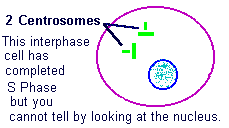
|
I hope you remembered that there should be TWO centrosomes because this is a late interphase cell.
(If you forgot to draw them at all, you should remember next time because they are very important.) Notice that the nuclear membrane is still intact. That is a sign that we are in interphase. I hope you got that right. Also, remember that you really need to draw the cell membrane too in order to contain all that is happening. |
Draw and label (late) prophase or prometaphase.

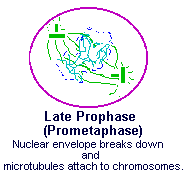
|
During prometaphase two very important events occur and I hope you drew them.
1. The nuclear envelope breaks down. 2. The fibers of the spindle (the spindle is the thing radiating away from the centrosomes) attach to chromosomes at their centromeres - but you cannot really see them clearly yet. The spindle fibers are made of microtubules. (Actually the protein is called "microtubulin".) |
Draw and label metaphase for a cell with a diploid number of four (2n = 4).
Be sure you label the important structure that defines the cell as being in metaphase.

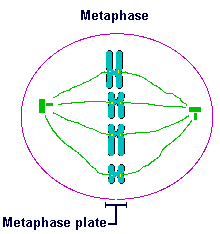
|
I hope your drawing shows all four chromosomes lined up midway between the two centrosomes. They will be in dyads (normal X-shaped chromosomes). If you showed them in tetrads, you are confusing it with metaphase I of meiosis.
Also, there should be clear and obvious connections, made by the fibers, between each chromosome's centromere and the centrosomes on either side. Did you label the metaphase plate? Remember, it is this "line up" that defines metaphase and makes it so obvious. |
Draw the anaphase of the above cell.
How many chromosomes does it now have at anaphase?

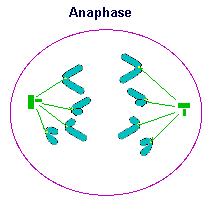
|
I hope your drawing shows all four chromosomes being torn in half, producing eight chromosomes, and getting dragged to opposite poles.
It may be difficult to draw them as nicely as I have (  ) but I hope you understand that they tend to be pulled into V-shapes as they are pulled towards each centrosome. ) but I hope you understand that they tend to be pulled into V-shapes as they are pulled towards each centrosome.
The moment the chromosome's centromere splits each kinetochore acts as the center for the creation of a new centromere. That means each sister chromatid is now an entire chromosome - by definition. Therefore, this cell which in metaphase had four chromosomes, now has eight! |
Draw the telophase of the above cell.
How many chromosomes does the cell now have after telophase?

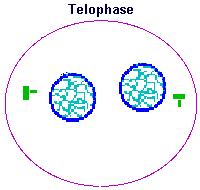
|
Your drawing should be similar to mine - showing two nuclei. The nuclear membrane has reformed around both of them. In my drawing the chromatin is starting to unwind and the chromosomes are starting to disappear.
Speaking of chromosomes, how many chromosomes does this CELL have? I hope you said it has eight chromosomes. There are four chromosomes in each nucleus. You cannot see them but they are there! Notice that, because this cell has not divided, it contains both sets - all eight chromosomes. |
That is the end of mitosis but what happens next - most of the time?
Cytokinesis!
Draw this cell going through cytokinesis (after mitosis). Make several drawings showing this animal cell progressing up to early interphase.
How many chromosomes does each cell now have after cytokinesis?


|
I hope your drawing similar to mine.
I have illustrated a progression in which the cell membrane is pinching in at the cell's middle, like a purse string, and eventually meeting in the middle.
I hope you didn't forget about the centrosomes.
You understand that NOW each cell has four chromosomes - although you cannot see them. |
Well, that was a complete run through mitosis - the most common form of nuclear division. I hope your drawings were similar to mine and that you remembered to keep track of the chromosomes, their numbers and shape, as well as the centrosomes.
Now let's move on to something a bit more complicated.
Define meiosis.

Meiosis is often called "reduction division" because the genetic material is reduced by half - from diploid to haploid.
What is achieved in meiosis in terms of the genetic materials? Why is meiosis necessary? Where does meiosis occur?

Meiosis produces diverse HAPLOID (n) nuclei.
If cells did not undergo meiosis, the fusion of diploid gametes would produce zygotes with twice as much genetic material as needed. This overload of genes is often lethal, so meiosis is required to produce healthy gametes and, thus, healthy zygotes.
Meiosis is a very specialized type of nuclear division occurring only in cells that will become gametes (sex cells - sperm and egg). So meiosis is required for sexual reproduction - using gametes.
Great. Now sharpen your colored pencils and let's go through meiosis! We will not draw ALL the stages of meiosis because some of them are very similar to mitosis. Instead, I will ask you only to draw the phases that are special.
Remember to draw the important structures that identify each phase paying particular attention where needed to chromosomes, centrosomes and both cell and nuclear membranes. Show a cell that has a diploid number of 4 (2n = 4) and color, or otherwise mark, the M and P chromosomes. Be sure you show proper tetrad or dyad patterns throughout. Assume it is an animal cell.
Draw metaphase I.

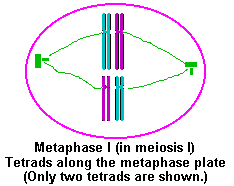
|
Your drawing should look similar to mine. Like all metaphases, the action is focused along the metaphase plate.
I have used different colors to represent the maternal and paternal chromosomes. You could have used different shading of colors - or even different textures such as straight versus wiggly lines. Regardless, I hope you drew the four chromosomes as proper tetrads. Each tetrad should be composed of one maternal and one paternal chromosome - of the same type (equal in length and position of the centromere). In this example there are only two pairs, so you should have drawn one pair, the #2's, smaller than the other. |
Also, you may have switched them, left and right. My example shows the tetrads arranged such that there will be a mix (P#1 & M#2 going left and M#1 & P#2 going right) but you could have switched them around.
Metaphase I is followed by anaphase I, so draw anaphase I.

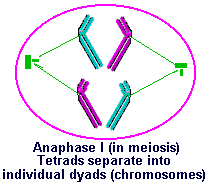
|
Your drawing should show that the tetrads are being pulled apart into separate dyads. Specifically, maternal and paternal pairs should be moving away from each other and towards their neighboring centrosomes,
Notice that the centromeres of each chromosome (dyad) are NOT being split. That is, no new chromosomes are being made at this point. That means the same number of chromosomes are being shared, evenly and consistently, between the two halves of the cell. Therefore, this is the true "reduction division" |
After anaphase I comes telophase I but it looks pretty much like any type of telophase so we will skip it. You will recall, some species skip telophase I anyway - because it's a waste of time and energy to rebuild new nuclear membranes and unwind the chromosomes only to reverse it all in the prophase II that follows.
As a matter of fact, let's not bother drawing prophase II either. It is not very interesting. Let's assume that cytokinesis has occurred and, to keep life simple, for the next two drawings draw only one cell - even though there are really two cells, each with a nucleus undergoing meiosis II.
The really important part comes in the next two phases so, start by drawing metaphase II.

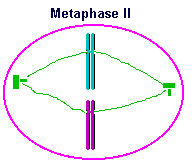
|
Your drawing of metaphase II should look something like this. Notice that there are only two chromosomes involved. That's because this cell started as 2n = 4 but was reduced to n = 2 in meiosis I. Also notice that these two chromosomes are different. It is important that they be different in size or shape to illustrate that they are NOT a homologous pair. (The homologs were separated in anaphase I.) In my example I have drawn a paternal (blue) #1 above a maternal (pink) #2 but you could have had it the other way around or even show both of the chromosomes to be paternal or maternal.
However, it would be WRONG to show any metaphase II with a tetrad or with any pairs - such as a pair of #1's or pair of #2's. |
By the way, if you skipped ahead to Lesson 5 you might be wondering about crossed over chromatids. In this Workshop I have decided to leave out that complication. However, crossing over would have occurred (in prophase I) so these chromosomes would have shown a mix of maternal and paternal bandings BUT we would track their migration through meiosis by following the origin (color) of the centromeres. Remember, a chromosome is always defined by its centromere.
OK, after metaphase II comes anaphase II. Draw it.

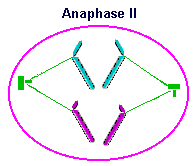
|
Your drawing should show the two chromosomes being torn in half and being pulled towards their nearest centrosome.
This anaphase (II) is very much like the anaphase of mitosis. (As a matter of fact, the metaphase II is very much like the metaphase of mitosis.) The only difference is that there are half as many chromosomes to worry about because of the reduction that occurred in the first meiosis. |
I hope the above exercises have been helpful. I know these drawings might seem a wee bit silly and even boring but drawing these structures is the best way to learn them and to learn how these nuclear divisions really affect chromosomes.
For this last part I want you to draw a "summary" of meiosis showing the ploidy of the cell and nucleus as it goes through meiosis I and meiosis II with the cytokinesis required to turn one diploid cell into four haploid cells. Assume a cell that has a diploid number of 4 (2n = 4).
Don't draw the chromosomes or the phases - just draw the cells and nuclei after each nuclear and cellular division. Also, write below each stage, the ploidy of the cells and nuclei.


This was a difficult summary to draw and write so don't feel bad if you missed some of the details. More importantly, correct your drawing so it has all the information that mine has.
Take a good look at the changing ploidies and pay attention as to whether I am talking about cell or nucleus. Some students get hung up here and have difficulty tracking the chromosome number through meiosis. If you do not understand, scroll up and have a look at the chromosomes as they go through anaphase I and II. Those are the crucial steps. And remember that a cell with two nuclei has twice as many chromosomes as each nucleus.
Now that we are done, pick up a copy of the answers to Mitosis and Meiosis Worksheet and compare it to your own Worksheet. Make sure you understand it.
 and
and  licensed under a Creative Commons Attribution-ShareAlike 4.0 International License.
licensed under a Creative Commons Attribution-ShareAlike 4.0 International License.
| Table of Contents | Homepage | How to get a FREE copy of the entire course (hypertextbook) | Frequently Asked Questions |